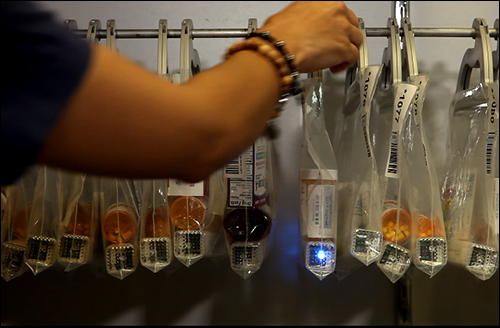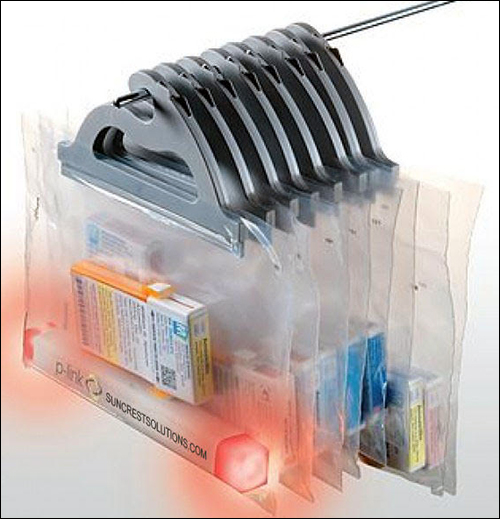North Carolina drug retailer Drugco Discount Pharmacy is the first mainland U.S.-based drugstore to employ an RFID light stick for pharmacy will-call. The system, provided by Suncrest Solutions in partnership with EZ-RFID, automates the retrieval process for prescription drugs when customers arrive at the counter to pick them up. The system, known as HangRx p-link, is designed to eliminate the need for drugstore employees to sift through bags of prescriptions searching for the correct one for a specific customer. By using passive ultrahigh-frequency (UHF) RFID, the system instead triggers a light stick to illuminate inside in a clear, plastic, hanging bag, leading workers to the right medication.
Since the automated will-call system was taken live in October 2016, says Drew Huggins, Drugco’s chief operating officer, it has saved approximately 10 hours of daily labor time that workers would otherwise spend looking for prescriptions.

Suncrest Solutions has been selling its HangRx pharmacy will-call software system for more than a decade, to help users manage the locations of prescriptions as they are filled and dispensed to customers. The solution interfaces with druggists’ existing pharmacy-management software so that they can use their own software to identify patients, insurance companies and the will-call location of a prescription that is ready for pick up, using the HangRx system, explains Jennie Larsen, Suncrest’s chief sales and marketing officer. In addition, the system can automatically call or text a patient once his or her order is ready.
EZ-RFID’s p-link RFID-enabled stick sends and receives transmissions via UHF RFID and illuminates built-in lights accordingly.
Last year, Larsen says, Suncrest and EZ-RFID partnered to combine their technology to provide a light-guided –retrieval system as part of an automated prescription will-call solution for drugstore employees. While the HangRx system could identify that a prescription had been filled, for whom and the bag number in which it was stored (based on a bar-code scan), the p-link light stick takes will-call retrieval a step further by reducing the time it takes to locate a prescription for a customer, the company reports.
The companies tested the full solution at a pharmacy in Puerto Rico, while Drugco is the first company in the United States to deploy the system. Drugco is a busy store, located in Roanoke Rapids, N.C. It fills about 1,300 prescriptions daily for around 600 patients, and has a manned drive-through window, as well as two additional staff members dedicated to finding and providing prescriptions for customers who enter the store.
Traditionally, Huggins says, those employees would identify a patient, including his or her last name, then proceed to an alphabetic bin storage system to seek the right prescription for that individual. This could mean sifting through 30 bags or more before finding the right one. In the meantime, the customer must simply wait.
With the new system using RFID technology, the company reports, the process is now faster. First, a patient brings in a prescription, which is entered into the system via the HangRX software, interfacing with the pharmacy-management software. The individual’s name, health record and insurance information are then paired to that order.

Once the prescription is filled, a staff member takes an empty bag, which comes with a p-link light stick with a built-in UHF RFID tag. The light stick is linked in the software to the bar-code number affixed to the bag’s front. As the prescription is placed in the bag, the employee scans the bar code, which forwards that data to the software, thereby storing the prescription with the bag ID. “At that point,” Larsen says, “they don’t have to alphabetized. They just hang up the bag.”
Upon arriving to pick up an order, a customer provides his or her name and birthdate. The employee uses the HangRx software to input that person’s name and view the prescription, then presses a prompt for the light stick to illuminate.
A desktop UHF RFID reader from EZ-RFID, cabled to the computer, transmits to that light stick, instructing it to illuminate. Six different colors can be connected to that request as well, so it could illuminate green for one employee, but blue for another, based on who makes the request—for instance, the worker manning the drive-through window could prompt only blue lights. The employee then walks to the clear bag containing the illuminated stick (it shines on both sides to ensure that it can be easily seen) and retrieves it.
Although other automated will-call systems can identify prescriptions as they are picked up, Larsen says, they require a higher cost system with illumination built directly into the custom bag handle or cabinets. Using RFID technology in the p-link sticks allows a pharmacy to convert any hang-up bag system to automated light-guided retrieval by downloading the HangRx software and acquiring the light sticks.
The HangRx p-link system is intended to be low-cost and easy to install, Larsen says. The company can set up the software for a user remotely, Larsen explains, and ship that user the light sticks and RFID reader. The user can then attend a GoToMeeting session for training, and start setting up the bags for use in the system.
Before the HangRx p-link system was deployed, Huggins says, it took approximately one or two minutes to find a properly stored prescription, and five to six minutes to locate a misfiled drug bag. With the new technology, it takes only 15 to 45 seconds to complete this task. “That’s a very conservative estimate,” Huggins adds. While that saves the drugstore the cost of those accumulated labor hours, it also helps with customer satisfaction.
“The whole feel of the process is more organized,” Huggins states. “Before, customers were watching us dig through bags to find their order. Now they can see the light,” he says, and watch as an employee walks directly to the appropriate bag.
Because each employee can be assigned his or her own color to illuminate the light sticks, Huggins adds, that makes it easy to differentiate which worker is seeking that item. For instance, he says, there have been times “when I’ll be walking by and see a bag light up with a red light, and then just hand the bag to the drive-through person,” since he knows that employee uses the red light.
Suncrest and EZ-RFID are working on a clip-on version of the light stick that would also illuminate and use RFID to receive those instructions, but that could be attached to drugs not kept in hanging bags, such as medication stored in refrigerators. Suncrest Solutions is currently preparing for a beta test with a national retail chain to use the technology in the same way.



